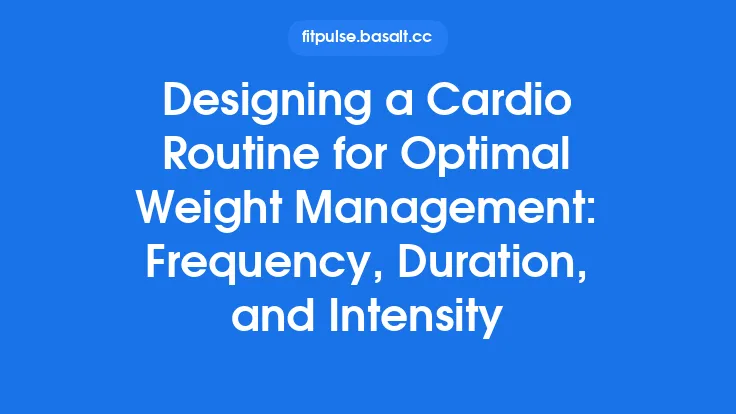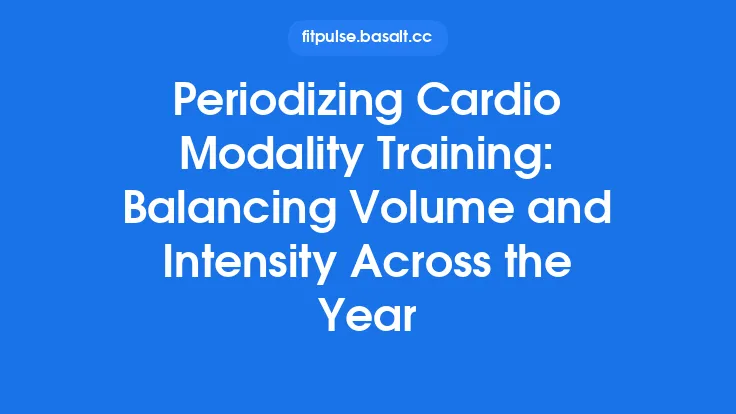Balancing load, volume, and intensity is the cornerstone of any well‑designed resistance‑training program. While each variable can be manipulated in isolation, true optimization emerges when they are considered together, allowing the practitioner to steer the body toward specific adaptations—whether that be maximal strength, muscular hypertrophy, or endurance. Understanding how these three pillars interact, how they can be measured, and how to adjust them over time equips coaches and athletes with a powerful toolkit for sustainable progress.
Defining Load, Volume, and Intensity
Load refers to the external resistance applied to the body during a movement, most commonly expressed as a percentage of an individual’s one‑repetition maximum (1RM) or as an absolute weight (kilograms or pounds). Load is the primary mechanical stimulus that challenges the musculoskeletal system.
Volume captures the total amount of work performed in a training session or over a defined period. It is typically quantified as the product of sets, repetitions, and load (e.g., total tonnage = sets × reps × load). Volume can also be expressed in more nuanced ways, such as “effective reps” (reps performed within a certain proximity to failure) or “time under tension” (TUT).
Intensity is often conflated with load, but in exercise science it denotes the relative effort required to complete a set. Intensity can be expressed as a percentage of 1RM, as a rating of perceived exertion (RPE), or as the proximity of a set to muscular failure (e.g., “3 reps in reserve”). While load contributes to intensity, the two are not synonymous; a light load lifted to failure can be highly intense, whereas a heavy load lifted far from failure may be less intense from a metabolic standpoint.
Physiological Basis of Load‑Driven Adaptations
When a load is applied, the body experiences mechanical tension, a primary driver of muscle protein synthesis. High loads (≥ 80 % 1RM) generate substantial intramuscular stress, activating mechanotransduction pathways such as the mTORC1 complex. This cascade promotes the synthesis of contractile proteins, leading to increases in cross‑sectional area (hypertrophy) and, over time, greater maximal force production.
In addition to mechanical tension, heavy loads stimulate the nervous system to improve motor unit recruitment, firing frequency, and synchronization. These neural adaptations are especially pronounced during the early phases of strength training and are essential for translating muscular gains into functional strength.
Volume as a Driver of Muscular Endurance and Hypertrophy
Volume dictates the cumulative exposure of muscle fibers to metabolic stress and muscle damage—two secondary but potent stimuli for adaptation. Moderate loads (≈ 60–75 % 1RM) performed for higher repetitions (≥ 12) increase the accumulation of metabolites such as lactate, hydrogen ions, and inorganic phosphate. This metabolic milieu triggers cellular swelling and the release of anabolic hormones, both of which support hypertrophic signaling.
Higher total volume also extends the duration of muscle fiber activation, fostering endurance adaptations. Repeated submaximal contractions improve oxidative capacity, capillary density, and mitochondrial content, enabling muscles to sustain work for longer periods.
Intensity and Neuromuscular Efficiency
Intensity, when expressed as proximity to failure or RPE, reflects the central and peripheral fatigue experienced during a set. High‑intensity efforts (e.g., 1–5 reps at ≥ 85 % 1RM or sets taken to 0–1 RIR) place a premium on the nervous system’s ability to generate rapid, high‑force outputs. Repeated exposure to such conditions enhances:
- Motor unit recruitment – more high‑threshold motor units are activated.
- Rate coding – the frequency of action potentials increases.
- Inter‑muscular coordination – synergistic muscles learn to fire in a more efficient pattern.
These neural adaptations are critical for translating strength gains into sport‑specific performance, especially in activities requiring explosive power.
The Load‑Volume‑Intensity Triangle: Finding the Sweet Spot
Imagine a triangle where each corner represents one of the three variables. Moving toward one corner inevitably pulls the other two away. For example:
- High load, low volume, high intensity – optimal for maximal strength but limited hypertrophic stimulus.
- Low load, high volume, low intensity – favors muscular endurance with modest strength gains.
- Moderate load, moderate volume, moderate intensity – often the most balanced zone for hypertrophy.
The “sweet spot” for a given goal lies somewhere along the edges of this triangle. The practitioner’s task is to locate the region that aligns with the desired adaptation while respecting the athlete’s training history, recovery capacity, and schedule.
Quantifying Load, Volume, and Intensity in Practice
| Variable | Common Metric | Calculation Example |
|---|---|---|
| Load | %1RM, absolute weight | 80 % 1RM = 0.80 × 150 kg = 120 kg |
| Volume | Total tonnage, sets × reps × load | 4 sets × 6 reps × 120 kg = 2,880 kg |
| Intensity | RPE, Reps‑In‑Reserve (RIR) | RPE = 9 (≈ 1 RIR) for a set of 5 reps at 120 kg |
| Time Under Tension (TUT) | Seconds per rep × reps | 3 s eccentric + 1 s concentric = 4 s/rep → 4 s × 6 reps = 24 s per set |
Advanced practitioners may also track “effective reps” (reps performed within the last 5 % of 1RM) to gauge the true hypertrophic stimulus, or use velocity‑based training (VBT) to infer intensity from bar speed.
Programming Strategies to Balance the Three Variables
- Linear Load Progression with Volume Modulation
Weeks 1‑4: 70 % 1RM, 4 sets × 10 reps (high volume, moderate intensity).
Weeks 5‑8: 80 % 1RM, 4 sets × 6 reps (reduced volume, increased intensity).
This approach gradually shifts the emphasis from hypertrophy toward strength while maintaining overall workload.
- Undulating (Non‑Linear) Schemes
Alternate daily or weekly between heavy, moderate, and light sessions. Example:
Monday: 85 % 1RM, 3 sets × 4 reps (high intensity, low volume).
Wednesday: 70 % 1RM, 4 sets × 8 reps (moderate intensity, moderate volume).
Friday: 55 % 1RM, 3 sets × 15 reps (low intensity, high volume).
This method provides frequent stimulus variation, reducing monotony and promoting broader adaptations.
- Cluster Sets for Intensity Management
Break a traditional set into mini‑sets with short intra‑set rests (e.g., 4 × 3 reps with 15 s rest). The external load remains high, preserving intensity, while the effective volume per cluster is lower, allowing higher quality repetitions.
- Reverse Pyramid Training (RPT)
Begin with the heaviest load for low reps, then reduce load while increasing reps across subsequent sets. This front‑loads intensity and load, then adds volume as fatigue accumulates.
Monitoring and Adjusting for Optimal Adaptation
- Performance Metrics – Track weekly changes in 1RM, rep max at a given load, or bar velocity. A plateau or decline signals the need to adjust one of the three variables.
- Subjective Measures – RPE and RIR provide immediate feedback on perceived intensity. Consistently high RPE despite unchanged load may indicate accumulated fatigue, prompting a volume reduction.
- Physiological Markers – While not always practical, monitoring creatine kinase, hormonal fluctuations, or heart‑rate variability can inform whether the current load‑volume‑intensity balance is sustainable.
- Progressive Adjustments – Small, incremental changes (2–5 % load increase, ±1 set, or ±2 reps) are generally more effective than large jumps, which can destabilize the balance and increase injury risk.
Common Misconceptions and Pitfalls
- “More Volume Is Always Better” – Excessive volume without adequate intensity can lead to diminishing returns and overuse injuries. Quality of work matters more than sheer quantity.
- “Heavy Load Equals High Intensity” – Intensity is also a function of effort relative to capacity. Light loads taken to failure can be just as intense metabolically.
- “One‑Size‑Fits‑All Load Prescription” – Even within a homogeneous population, individual differences in fiber‑type composition, biomechanics, and neuromuscular efficiency mean that the same %1RM can feel dramatically different.
- “Static Programming” – Sticking rigidly to a preset load‑volume‑intensity scheme ignores day‑to‑day fluctuations in readiness and can stall progress.
Advanced Considerations for Experienced Practitioners
- Load‑Velocity Profiling – By establishing a load‑velocity curve for each athlete, practitioners can prescribe loads that correspond to a target velocity, ensuring consistent intensity across sessions.
- Metabolic Stress Manipulation – Techniques such as blood‑flow restriction (BFR) or supersets can amplify metabolic stress at lower loads, effectively raising intensity without increasing mechanical load.
- Neuromuscular Fatigue Management – Incorporating “intensity spikes” (single heavy singles) within a high‑volume block can preserve neural drive while still delivering sufficient volume for hypertrophy.
- Periodized Volume‑Intensity Coupling – While avoiding full periodization concepts, short‑term (2‑4 week) blocks can be organized to gradually shift the load‑volume‑intensity ratio, providing a micro‑cycle of adaptation before returning to a baseline.
Practical Templates for Different Training Goals
| Goal | Primary Emphasis | Sample Weekly Layout (3‑day split) |
|---|---|---|
| Maximal Strength | High load, high intensity, low volume | Day 1: 85 % 1RM × 4 sets × 3 reps (RPE 9) <br> Day 2: 80 % 1RM × 5 sets × 4 reps (RPE 8) <br> Day 3: 90 % 1RM × 3 sets × 2 reps (RPE 9.5) |
| Hypertrophy | Moderate load, moderate‑high volume, moderate intensity | Day 1: 70 % 1RM × 4 sets × 10 reps (RPE 7) <br> Day 2: 75 % 1RM × 3 sets × 12 reps (RPE 8) <br> Day 3: 65 % 1RM × 5 sets × 15 reps (RPE 6‑7) |
| Muscular Endurance | Low load, high volume, low‑moderate intensity | Day 1: 50 % 1RM × 3 sets × 20 reps (RPE 6) <br> Day 2: 55 % 1RM × 4 sets × 18 reps (RPE 6‑7) <br> Day 3: 45 % 1RM × 5 sets × 25 reps (RPE 5‑6) |
| Power Development | High intensity, low volume, emphasis on speed | Day 1: 60 % 1RM × 5 sets × 3 reps (explosive, RPE 8) <br> Day 2: 70 % 1RM × 4 sets × 2 reps (fast, RPE 8‑9) <br> Day 3: 50 % 1RM × 6 sets × 4 reps (ballistic, RPE 7) |
These templates illustrate how shifting the balance among load, volume, and intensity can produce distinct adaptations while keeping the overall training stimulus coherent.
Closing Thoughts
Balancing load, volume, and intensity is less about rigid formulas and more about dynamic negotiation between mechanical tension, metabolic stress, and neural effort. By mastering the definitions, physiological underpinnings, and practical measurement tools for each variable, practitioners can craft programs that consistently push the body toward the desired adaptation while minimizing unnecessary fatigue. Continuous monitoring, thoughtful adjustments, and an awareness of common misconceptions ensure that the load‑volume‑intensity triangle remains a reliable guide rather than a static constraint. In the end, the art of programming lies in recognizing where each athlete sits within that triangle and gently nudging them toward the optimal corner for their goals.





